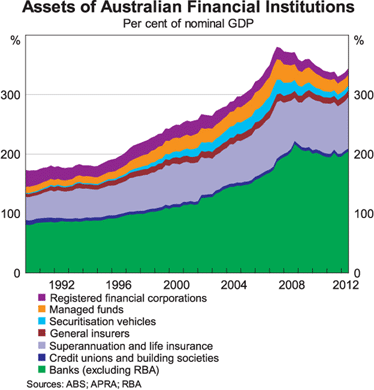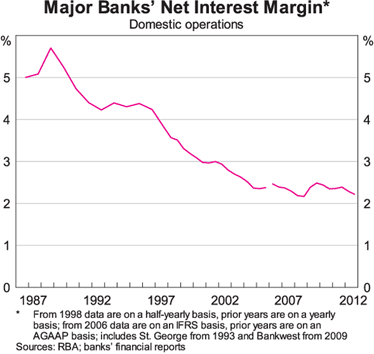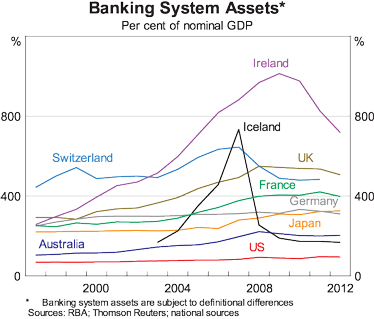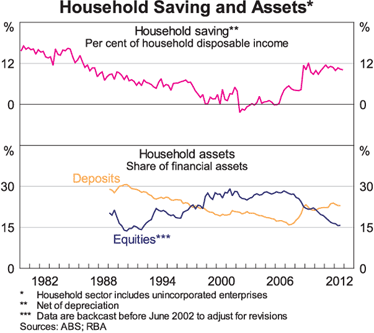
Find below a very good speech today given by RBA Asssitant Governor Malcolm Edey on the history of pre and post GFC banks and lending. I could punch a few holes in it but in toto it is a very thoughtful dissertation on where we’ve been, where we are and where we’re going. Recommended reading.
The Financial System in the Post-crisis Environment
Malcolm Edey
Assistant Governor (Financial System)
Remarks to the Australian Centre for Financial Studies (ACFS) and Financial Services Institute of Australasia (Finsia) Leadership Luncheon Series
Melbourne – 22 March 2013
I want to talk today about how the financial system has changed in the post-crisis environment. In order to think about that, it is useful first to look back at the enormous changes that took place in the roughly quarter-century period between financial deregulation and the onset of the global financial crisis (GFC). Then I want to ask how far those earlier trends might be expected to reassert themselves as conditions normalise.
Perhaps the most obvious aspect of that earlier period of change was in the financial sector’s relative size. To give a few summary measures:
- The ratio of credit to GDP increased from around 50 per cent in the mid 1980s to around 160 per cent in 2007.
- Over the same period, the total assets of the banking system rose from around 50 to around 200 per cent of GDP (Graph 1).
- Measures of financial market turnover increased dramatically on a range of fronts. To give just one example, foreign exchange turnover increased by a factor of more than 30 in nominal dollar terms over that quarter-century, when the nominal economy itself expanded only by a factor of 4½.
Graph 1

The system also changed profoundly in other ways than just size. One was in its degree of openness to competition and in the nature of that competition. The post-Campbell reforms allowed market forces to work, and opened up the system to new competitors. The Wallis reforms followed that up by placing the regulation of banks and non-bank intermediaries on a more equal footing.
We can see the consequences of these forces in the cost and availability of financial services to end users. Deregulation ended the artificial rationing of bank loans, making credit much more widely available. Another consequence that we are apt to forget is that the cost of financial intermediation came down very substantially. In the late 1980s the average net interest margin of the major banks was more than 5 percentage points. By the middle of the last decade it had fallen to a level less than half that – where, broadly speaking, it still is today. So finance became both cheaper and more widely available (Graph 2).
Graph 2
These forces also had the effect of changing the focal point of competition. The rationing that existed in the old regulated environment had encouraged banks to compete on a ‘whole of institution’ basis, rather than at the level of individual product lines. In effect, banks offered a package of loan, deposit and payment services and competed for customers at the level of the package as a whole. In this situation, wide interest margins were used to cross-subsidise payment services, and customer mobility was limited because loyalty to a bank was one of the critical factors in obtaining access to scarce loans. Deregulation changed that model by allowing innovators to compete separately for the most profitable lines of business. Cross-subsidies in the banking system were competed down, and this helped to drive the reduction in net interest margins. It is interesting to note that for much of the pre-crisis period, competition among financial intermediaries was focused mainly on the lending side of the business. In effect, intermediaries could operate with a business model that assumed the availability of funding, and mainly competed for market share in lending out the available funds. This is one of the things that has changed since the GFC. With investors now much more discerning in their risk assessments, banks have had to compete harder in the deposit and other funding markets, and this is changing the way they do business. I will return to this point later when I conclude. A final area to mention in briefly rounding up the pre-crisis environment is the growth of the wealth management sector. Funds under management (principally in superannuation and life offices) expanded from around 30 to around 130 per cent of GDP between 1985 and 2007, broadly matching the growth rate seen in the deposit and loan sector. And, of course, there has been a huge growth in services related to asset and risk management, including securities and derivatives trading. Many of these developments had their counterparts in overseas financial systems, which is not surprising because the same sorts of forces were at work. The majority of high-income economies experienced high rates of credit growth and in some cases financial activity expanded even faster than was the case in Australia. In the post-crisis environment these trends have slowed down, halted or in some cases partly reversed. In Australia the credit and debt measures that I cited earlier have been broadly stable for the past five years. Internationally, credit has contracted in nominal terms in some markets. There has also been a big change in attitudes and perceptions about financial risk. Although confidence in global markets has partly returned, risk appetite now is clearly not what it was. And certain kinds of financial activity, particularly in wholesale, securities and derivatives markets have settled at much lower levels than they were in the pre-crisis period. All of this raises the question as to what the new normal might look like in our financial systems. Has the world changed forever? To what extent can we expect the earlier causal factors driving financial change to reassert themselves? In thinking about this, I find it useful to categorise these causal factors into three groups. I see these as being conceptually distinct even though they are likely to interact in complex ways in practice. In the first group are the long-run forces driven by trends in incomes, technology and demographics. Viewed in the abstract, there are a number of reasons to think that financial activity might be able to grow faster than the general economy for sustained periods, and even that this configuration might be some kind of norm. On the demand side it seems plausible that, as people get richer, more of their income can be spent on financial services, including debt servicing, as proportionately less needs to be spent on necessities. Associated with this, the relative value of scarce assets that are financed by debt might be expected to rise over time. And the combination of increasing wealth and greater longevity in our societies is likely to generate rising demand for services in the wealth management and retirement income sector. On the supply side, the key point is that finance is an information-intensive industry. Its key outputs depend on the capacity to store, analyse and transmit information securely. We’re not actually very good at measuring the real value of financial outputs and hence not good either at measuring productivity in the sector. But it would be surprising if the ongoing advances in information technology were not generating significant growth in finance industry productivity relative to that in less information-intensive sectors. This is a process that can continue as long as the technology itself goes on improving. So there are some valid reasons to think that both supply and demand for financial services can grow faster than nominal incomes over time, other things being unchanged. The second set of forces to consider are the one-off factors that made this particular quarter century, in financial terms, unique. One of these I have already alluded to: the financial deregulation that took place around the world mainly in the late 1970s and early 1980s. Fundamentally, we have moved from a situation where credit was price-controlled and quantity-rationed, to one where credit availability is market determined. It is probably fair to say that the credit expansions that followed this shift around the world were larger and more protracted than many had expected. Nonetheless, it was by nature a one-time adjustment, and one that has probably now run its course. Another factor in the one-off category is the transition to low inflation and the consequent fall in nominal interest rates. In the late 1980s, mortgage interest rates in Australia reached a now unimaginable 17 per cent. Although that peak was partly cyclical, it also partly reflected the inflation premium built into the interest rate structure. As inflation expectations and nominal interest rates came down in the 1990s, there was a corresponding increase in the average household’s capacity to borrow. As a simple illustrative calculation, if we assume a debt service ratio of 30 per cent on a standard 25 year mortgage, a household’s borrowing capacity would have gone from around two times annual income in the late 1980s to something like four times income a decade and a half later. Taken in combination with the removal of regulatory constraints on credit supply, this would go a long way towards explaining the quarter-century rise in household debt ratios. The adjustment to this new reality seems to have been spread over a fairly lengthy period of time. But again, with inflation having been low and stable for more than two decades now, it can be seen as essentially a one-off factor that has probably run its course. My third category of forces are those associated with the cyclical dynamics of credit and asset prices. The financial sector has a well-documented capacity to engage in bouts of overexpansion, driven by self-reinforcing expectations and followed by periods of readjustment and consolidation. Credit cycles of this nature can be unpredictable in duration, ranging from the short and sharp to longer episodes spanning a decade or more. But we can think of these dynamics as being superimposed on the longer-term forces that I ‘ve already described. Even though these forces might be conceptually distinct, they are in practice likely to be highly interconnected. A financial bubble doesn’t usually come out of nowhere. Typically it starts as a well-based reaction to some genuinely new event, but then develops a self-fulfilling momentum of its own, often with elements of irresponsibility, dishonesty and outright fraud as part of the mix. Globally, there were certainly elements of bubble-like behaviour in the few years leading up to the GFC. But we can also pose the question of whether the world financial system overexpanded on a longer timescale, maybe a quarter-century scale, in reacting to the various forces that I’ve been describing. Did the financial sector in aggregate become too big relative to the size of the real economy? And if so, does that mean we are in for a period of ongoing correction to restore the balance? It is hard to be definitive about these things, but a few observations seem relevant: Graph 3 Graph 4 So what of the future? To return to my three sets of causal factors: The ongoing development of the financial system in the post-crisis period will depend on the interplay of those three factors. On any reading, it seems clear that this will be an environment where it is harder in general for banks and for the system as a whole to grow. While it is difficult to specify what that might mean in numerical terms, a return to financial sector growth rates consistently higher than the growth of nominal GDP seems unlikely for the foreseeable future. That is my first concluding comment. My other comment concerns the nature of competition. The pre-GFC quarter century was an unusual period, in that competition in financial intermediation came to be focused mainly on the lending side of the balance sheet. That now looks to have been an aberration, and we seem to be entering a period where significant competition on both sides of the balance sheet becomes the norm. It might take some time to get used to this new reality. But in general I see it as a healthy development because it will mean banks being under greater market discipline to manage their risks. And of course, regulators will be doing their part on that front as well.



